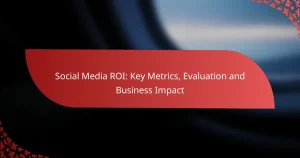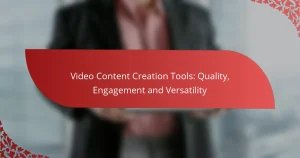Social media management tools are essential for enhancing engagement by simplifying content creation, scheduling, and performance tracking. By utilizing these tools, businesses can maintain a consistent posting schedule, analyze audience interactions, and refine their strategies to increase reach and engagement.
User-Generated Content: Engagement Enhancement on Facebook
User-generated content (UGC) plays a crucial role in enhancing engagement on Facebook by creating a sense of community and authenticity. By inviting users to share their experiences, brands can produce…
Key Metrics: Tracking Engagement, Reach, and Conversion
Tracking key metrics such as engagement, reach, and conversion is essential for understanding the effectiveness of your content and marketing strategies. By analyzing user interactions, audience growth, and conversion rates,…
Custom Reports: Setting Up for Social Media Performance
Setting up custom reports for social media performance is essential for tracking key metrics and gaining valuable insights into your strategies. By defining your goals, selecting appropriate tools, and integrating…
Social Media ROI: Key Metrics, Evaluation and Business Impact
Understanding social media ROI is crucial for businesses aiming to maximize their online presence and profitability. By evaluating key metrics such as engagement, conversions, and customer acquisition costs, companies can…
Analytics: Enhancing Instagram Marketing Strategy
Analytics plays a crucial role in enhancing Instagram marketing strategies by offering valuable insights into audience behavior and content performance. By utilizing data-driven tools, marketers can tailor their approaches to…
Comment Responses: Best Practices for Engagement
Engaging with users through comment responses is a powerful way to enhance interaction and build a sense of community around your brand. By personalizing replies, responding promptly, and maintaining a…
Polls and Questions: Engagement Boosters on Instagram
Polls and questions are powerful tools for boosting engagement on Instagram, fostering a sense of community and encouraging user interaction. By utilizing features like Stories, question stickers, and live polls,…
Content Calendars: Organization, Planning and Efficiency
Content calendars are essential tools for marketing teams, providing a structured framework that enhances organization and planning. By visualizing content strategies, these calendars ensure team alignment and timely execution of…
Collaboration Tools: Integration with Social Media Management Platforms
Collaboration tools play a crucial role in enhancing the efficiency of social media management platforms through seamless integration. By utilizing direct API connections and third-party services, these tools facilitate improved…
Instagram Scheduling: Best Practices for Small Businesses
For small businesses looking to enhance their Instagram presence, effective scheduling is key to maintaining consistent engagement and maximizing reach. Utilizing dedicated scheduling tools allows for advanced content planning and…
How can social media management tools increase engagement?
Social media management tools can significantly boost engagement by streamlining content creation, scheduling, and performance analysis. These tools enable businesses to post consistently, analyze audience interactions, and tailor their strategies to maximize reach and interaction.
Content scheduling features
Content scheduling features allow users to plan and automate their posts across various platforms, ensuring timely and consistent engagement. By scheduling posts during peak audience activity times, businesses can enhance visibility and interaction rates.
Many tools offer a calendar view, making it easy to visualize upcoming content. This helps avoid last-minute rushes and ensures a balanced content mix, which is crucial for maintaining audience interest.
Analytics and reporting capabilities
Analytics and reporting capabilities provide insights into how content performs, helping businesses understand what resonates with their audience. Metrics such as likes, shares, comments, and click-through rates can guide future content strategies.
Regularly reviewing these analytics enables businesses to identify trends and adjust their tactics accordingly. For example, if a particular type of post consistently garners high engagement, it may warrant more frequent posting.
Audience targeting options
Audience targeting options allow businesses to tailor their content to specific demographics, interests, or behaviors. This ensures that posts reach the most relevant users, increasing the likelihood of engagement.
Effective targeting can be achieved through features that segment audiences based on criteria like location, age, or past interactions. This precision helps in crafting messages that resonate deeply with specific groups, enhancing overall engagement rates.
Integration with other platforms
Integration with other platforms streamlines workflows by connecting social media management tools with email marketing, customer relationship management (CRM) systems, and analytics software. This connectivity enhances data sharing and allows for more cohesive marketing strategies.
For instance, integrating with a CRM can help businesses personalize their social media outreach based on customer data, leading to more meaningful interactions. Ensuring that all platforms work together effectively can significantly amplify engagement efforts.
What are the top social media management tools for engagement in the US?
The leading social media management tools for engagement in the US include Hootsuite, Buffer, Sprout Social, and Later. These platforms help businesses streamline their social media strategies, enhance audience interaction, and analyze performance metrics effectively.
Hootsuite
Hootsuite is a comprehensive social media management tool that allows users to schedule posts, monitor engagement, and analyze performance across multiple platforms. Its user-friendly dashboard makes it easy to track interactions in real-time and respond promptly to audience inquiries.
One of Hootsuite's standout features is its extensive analytics capabilities, which provide insights into audience behavior and engagement trends. This data can help businesses refine their content strategies to better resonate with their target demographics.
Buffer
Buffer is known for its simplicity and effectiveness in scheduling posts and analyzing social media performance. Users can easily plan their content calendar and receive suggestions on optimal posting times to maximize engagement.
Buffer's analytics tools provide valuable feedback on post performance, helping users understand what types of content generate the most interaction. This insight allows businesses to adjust their strategies and focus on high-performing content types.
Sprout Social
Sprout Social offers a robust suite of tools for social media management, including scheduling, monitoring, and in-depth analytics. Its intuitive interface allows users to manage multiple accounts seamlessly while tracking engagement metrics across platforms.
One of Sprout Social's key strengths is its customer relationship management (CRM) features, which enable businesses to engage with their audience more effectively. By tracking conversations and interactions, companies can build stronger relationships with their followers.
Later
Later is particularly popular for visual content planning, making it an excellent choice for brands focused on Instagram and other image-centric platforms. Users can visually plan their posts using a drag-and-drop calendar, ensuring a cohesive aesthetic across their social media feeds.
Later also provides analytics to track engagement and optimize posting schedules. This feature is essential for brands looking to enhance their visibility and interaction rates on social media platforms.
What features should you look for in a social media management tool?
When selecting a social media management tool, prioritize features that enhance usability, support multiple platforms, and provide real-time engagement insights. These functionalities are crucial for effectively managing your social media presence and maximizing audience interaction.
User-friendly interface
A user-friendly interface is essential for efficient navigation and task completion. Look for tools that offer intuitive layouts, drag-and-drop features, and customizable dashboards. This can significantly reduce the learning curve and help you focus on strategy rather than technicalities.
Consider tools that provide tutorials or customer support to assist with onboarding. A clean design with clear icons and labels can also enhance your experience, making it easier to manage posts and track engagement.
Multi-platform support
Multi-platform support allows you to manage various social media accounts from a single tool. Ensure the tool you choose can integrate with major platforms like Facebook, Twitter, Instagram, and LinkedIn. This capability streamlines your workflow and ensures consistent messaging across channels.
Check if the tool allows scheduling posts for different platforms simultaneously, which saves time and effort. Additionally, look for features that enable cross-platform analytics to compare performance metrics easily.
Real-time engagement tracking
Real-time engagement tracking is vital for understanding how your audience interacts with your content. Choose a tool that provides instant notifications for comments, likes, and shares, allowing you to respond promptly and maintain engagement.
Effective tracking should include analytics dashboards that display key metrics such as engagement rates, reach, and audience demographics. This data helps you adjust your strategy quickly and capitalize on trending topics or successful posts.
How do pricing plans affect social media management tool choices?
Pricing plans significantly influence the selection of social media management tools, as they determine the features available and the overall value received. Businesses must evaluate their needs against the costs to find a suitable balance between functionality and budget.
Free vs. paid plans
Free plans often provide basic functionalities, making them suitable for individuals or small businesses just starting with social media management. However, these plans may have limitations such as restricted analytics, fewer social profiles, or limited scheduling options.
Paid plans typically offer advanced features like in-depth analytics, team collaboration tools, and enhanced customer support. For businesses looking to grow their online presence, investing in a paid plan can lead to better engagement and more effective management.
Features included in different tiers
Different pricing tiers come with varying features that cater to different user needs. For instance, entry-level plans may include basic scheduling and posting capabilities, while higher tiers often provide advanced analytics, content curation, and social listening tools.
It’s essential to compare what each plan offers. For example, a mid-tier plan might include features like automated reporting and custom branding, which can be beneficial for brands aiming to maintain a professional image across platforms.
Cost-effectiveness for small businesses
For small businesses, choosing a cost-effective social media management tool is crucial. A well-selected plan can enhance engagement without straining the budget. Many tools offer tiered pricing that allows businesses to start with a basic plan and upgrade as their needs grow.
Consider the return on investment (ROI) when evaluating plans. A small monthly fee for a paid plan may lead to increased engagement and customer acquisition, ultimately justifying the expense. Look for tools that offer trial periods to assess their value before committing to a subscription.
What are the best practices for maximizing engagement?
Maximizing engagement on social media requires a strategic approach that includes a consistent posting schedule, effective use of analytics, and active interaction with followers. These practices help create a vibrant online presence that encourages user participation and loyalty.
Consistent posting schedule
Maintaining a consistent posting schedule is crucial for keeping your audience engaged. Aim to post at least a few times a week, but adjust based on your audience's preferences and platform norms. Tools like social media calendars can help you plan and automate your posts.
Consider the best times to post based on when your audience is most active. For example, evenings and weekends often yield higher engagement rates. Regularly review your posting frequency to ensure it aligns with audience feedback and engagement metrics.
Utilizing analytics for strategy
Leveraging analytics is essential for refining your social media strategy. Most platforms offer insights into post performance, audience demographics, and engagement rates. Use these metrics to identify what content resonates best with your audience.
Focus on key performance indicators (KPIs) such as likes, shares, comments, and click-through rates. Regularly analyze this data to adjust your content strategy, ensuring it remains relevant and engaging. A/B testing different types of posts can also provide valuable insights into audience preferences.
Engaging with followers
Active engagement with your followers fosters a sense of community and loyalty. Respond to comments and messages promptly, and encourage discussions by asking questions or seeking feedback on your posts. This interaction shows that you value your audience's opinions.
Consider hosting live Q&A sessions or polls to further engage your audience. These interactive elements can significantly boost engagement rates and create a more dynamic online presence. Remember to acknowledge user-generated content and share it to strengthen community ties.





